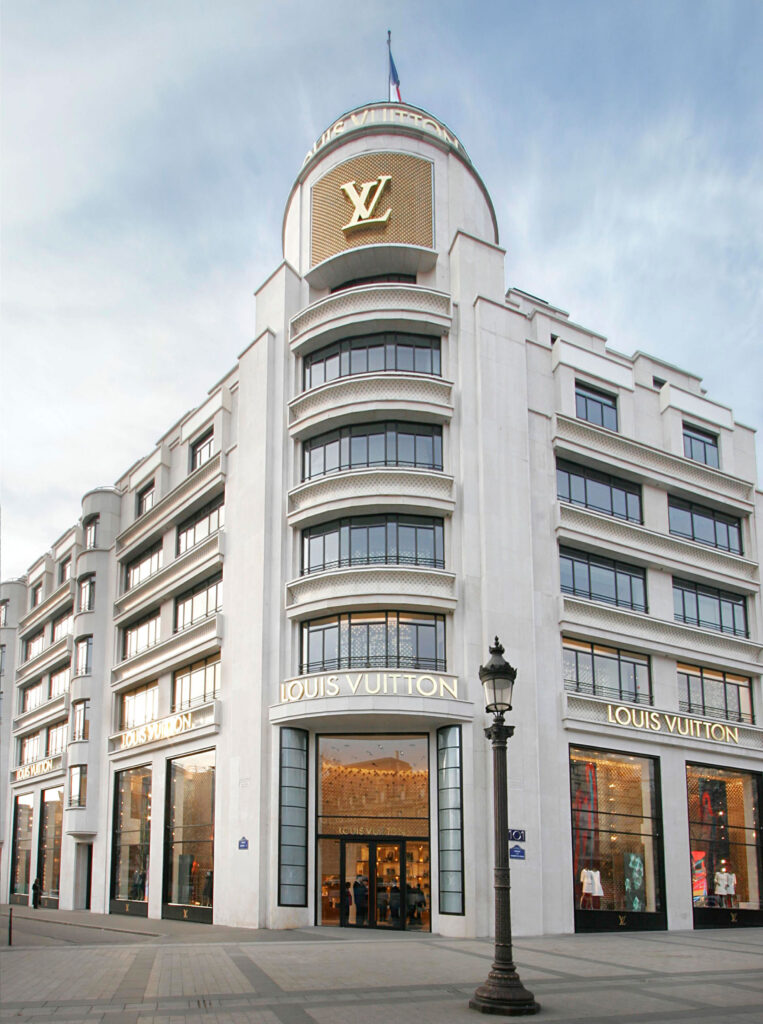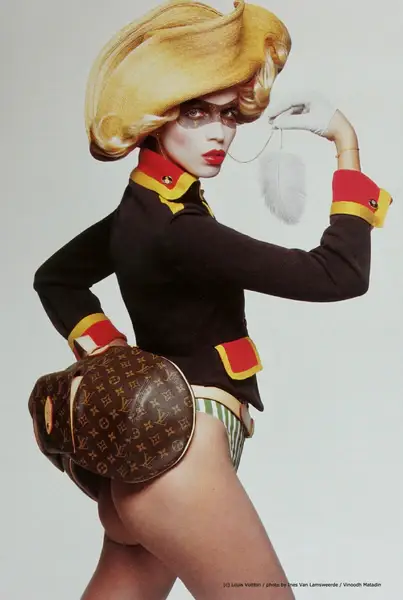If there’s one thing Louis Vuitton absolutely nails, it’s turning something as simple as initials into an international symbol of luxury. You know that rush you feel when you grab your favorite LV bag? That’s not just fashion; it’s a little piece of history in your hands. But how did this legendary logo come to be, and why is it still the ultimate travel and style companion? Let’s dive into the fascinating story of the LV monogram—complete with a few fun facts and insider tips!
In 1837, a 16-year-old Louis Vuitton arrived in Paris on foot and began an apprenticeship with the renowned trunk maker Monsieur Maréchal. At the time, travel relied on horse-drawn carriages, boats, and trains, with luggage often enduring rough handling. Travelers sought skilled craftsmen to carefully pack and protect their belongings.
Louis Vuitton quickly earned a reputation as a talented artisan in Monsieur Maréchal’s Parisian workshop. This experience laid the foundation for his expertise in creating bespoke travel pieces. Vuitton honed his craft in designing and constructing custom boxes and trunks tailored to clients’ specific needs.

Where It All Began: 1854-1896 🌟
After 17 years of perfecting his trade, in 1854, he opened his own workshop at 4 Rue Neuve-des-Capucines, near the iconic Place Vendôme, marking the beginning of his legendary journey. Louis Vuitton himself revolutionized travel with flat-topped trunks that were as chic as they were practical. These trunks were a total game-changer, making travel stylish for the first time. Fast forward to 1896, and Louis’s son, Georges Vuitton, created the iconic LV monogram to honor his dad and, let’s be honest, outsmart the copycats already trying to replicate their fab designs.
The logo was pure genius—featuring “LV” initials intertwined with Japanese-inspired floral motifs. Why Japanese art? Georges was inspired by the global art trends of the time, adding a sophisticated yet innovative flair to the brand.
Ah, I just love how the story behind the Louis Vuitton monogram is packed with fascinating cultural references! This inspiration from Japanese art dates back to the late 19th century, during a time when Japan was just beginning to open up to the world after over two centuries of isolation (known as the Edo Period). Europe was in the midst of a craze for the “exotic,” and Japanese aesthetics—known as Japonisme—were captivating artists, designers, and even luxury brands.
Georges Vuitton, the genius behind the iconic LV monogram in 1896, was a true visionary. He wanted to create a striking pattern that would be impossible to replicate (because, yes, counterfeiters were already a thing back then!). The choice of flowers, stars, and the perfectly symmetrical design was clearly inspired by traditional Japanese prints, like those found on kimono fabrics and ukiyo-e woodblock art.
Japanese culture is renowned for its meticulous attention to detail and its minimalist, balanced aesthetic. Georges wove this philosophy into the monogram’s design, creating something elegant, symmetrical, and undeniably international. The result? A timeless pattern that remains synonymous with sophistication and luxury even today.
Oh, and the flowers? They’re not just pretty—they reflect the deep connection between Japanese art and nature, with floral symbolism being a core element of the culture. Every detail seems to have been thoughtfully curated to exude that blend of simplicity and refinement that Japonisme is all about.
Fun fact: This influence was so impactful that the monogram pattern continues to be one of the most recognized and celebrated designs in the world—a true classic with global cultural roots!
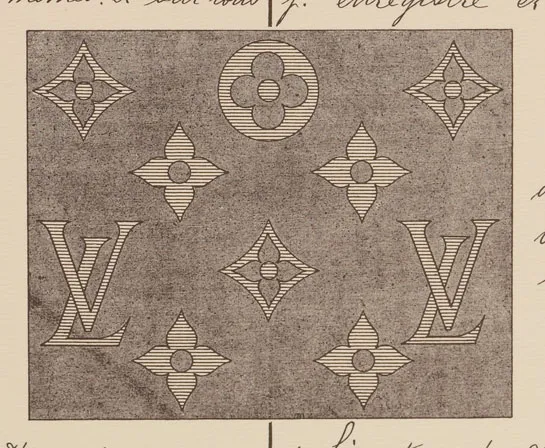
Why the Monogram? 🧐
Here’s the tea: Georges didn’t create the monogram just for aesthetics (though it’s stunning, obviously). Back in the late 1800s, Louis Vuitton trunks were the status symbol, and counterfeiters couldn’t resist trying to copy them. So Georges designed the LV monogram to be not just beautiful but also hard to replicate. Those intricate floral motifs weren’t just for show—they were part of the first “anti-fake” strategy in fashion!
Think about it: over 125 years later, it’s still one of the most copied logos in the world, and yet nothing beats the real deal. (Pro tip: If you’re shopping second-hand, always double-check authenticity. And yes, we’ve got a guide for that 😉—link it here!)
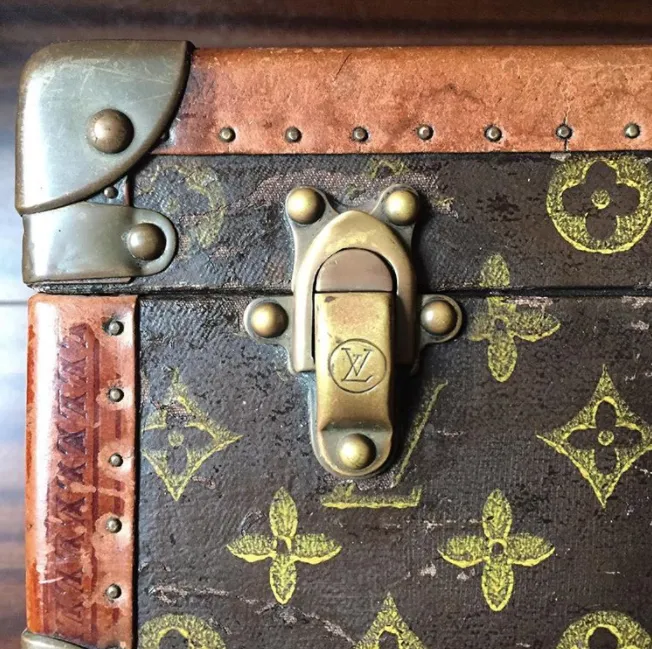
A Logo That Stood the Test of Time 🕰️
One of the coolest things about the Louis Vuitton logo? It’s barely changed since 1896. The intertwined initials, the elegant floral designs, and that timeless monogram canvas have become a universal symbol of class and exclusivity. And while the classic brown-and-gold combo remains iconic, Louis Vuitton hasn’t been afraid to mix things up over the years.
Pop Art Meets Luxury 🎨
Let’s talk about when Louis Vuitton got playful with the logo. Under Marc Jacobs’ creative direction in the early 2000s, the brand collaborated with artists like Takashi Murakami and Stephen Sprouse to give the monogram a modern twist. Think vibrant rainbow colors, edgy graffiti vibes, and a whole new generation of LV lovers. These collaborations turned the monogram into a cultural phenomenon, blending art, fashion, and fun.
And more recently, Virgil Abloh took the LV monogram into the world of streetwear, making it a staple for a younger, edgier crowd while keeping the brand’s heritage intact.
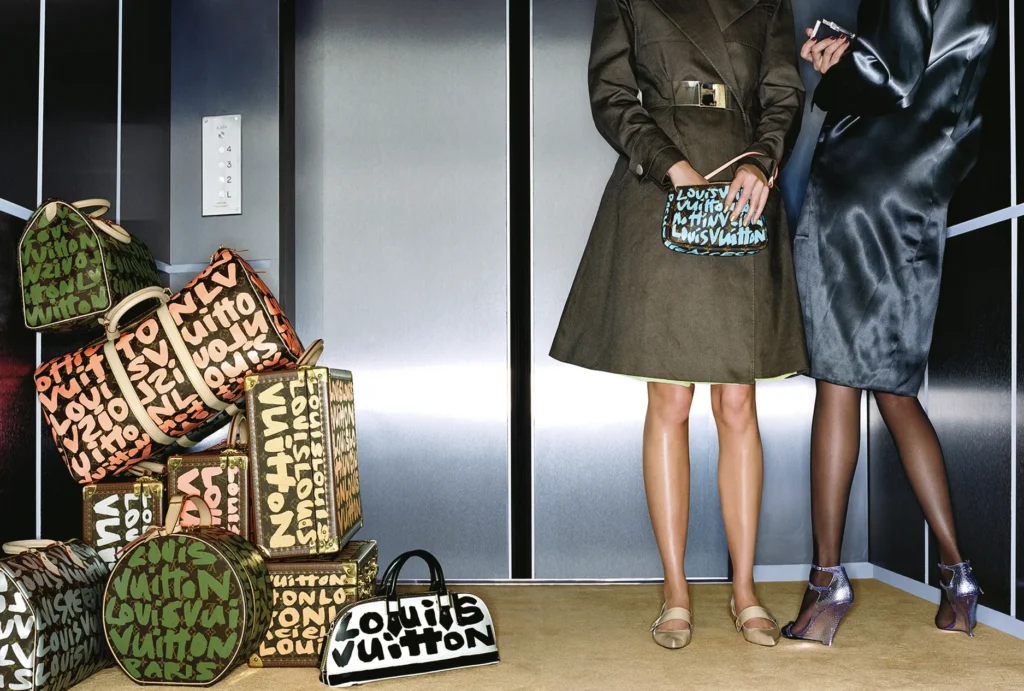
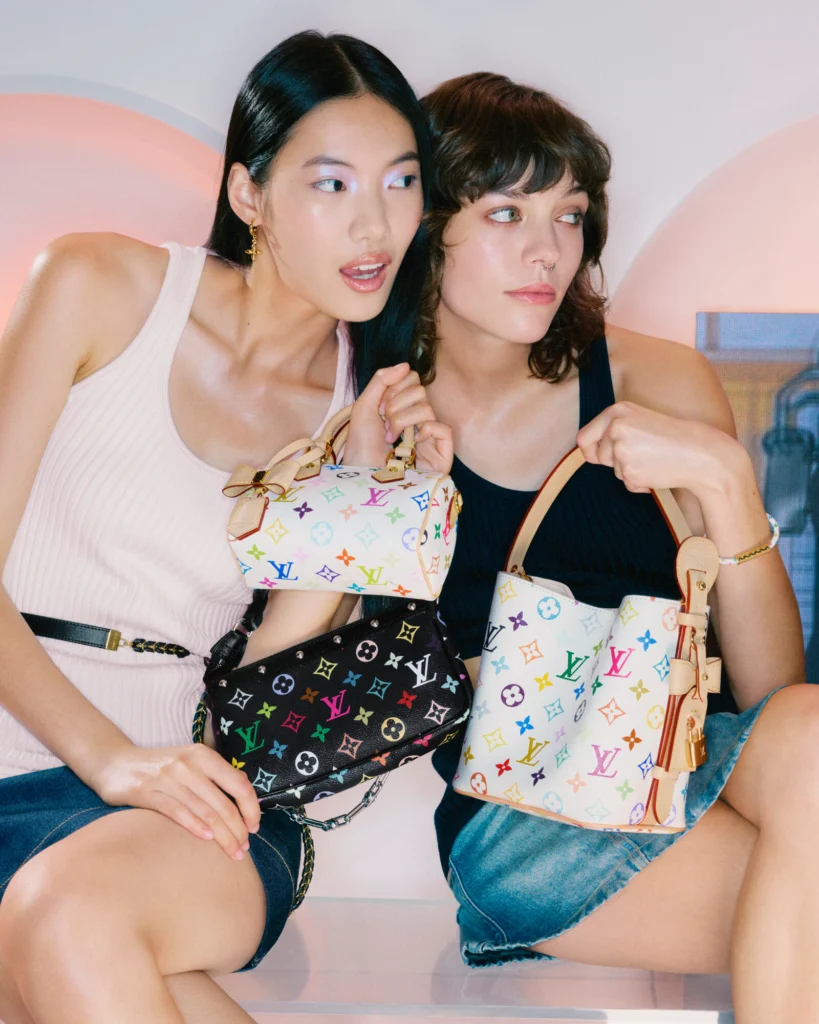
The Monogram’s Global Influence 🌍
More than a logo, the LV monogram is a global status symbol. Whether it’s on a vintage Speedy, a sleek Capucines, or a collectible trunk, it’s instantly recognizable. Oh, and did I mention that Louis Vuitton is part of LVMH, the world’s most valuable luxury group, worth over $500 billion? Like, excuse me while I clutch my bag a little tighter. 😍
If you’ve listened to hip-hop radio in the last 10 years, you know that from Jay-Z to Cardi B, Louis Vuitton gets name-dropped in lyrics almost as often as love and money.
And speaking of money, let’s talk about the most expensive Louis Vuitton item ever made—the Louis Vuitton Urban Satchel, which was priced at a jaw-dropping $150,000. This ultra-exclusive handbag was literally made from recycled materials, including cigarette packs, water bottles, and chewing gum wrappers, all stitched together into one avant-garde masterpiece. Talk about turning trash into treasure!
Oh, and if you’ve ever binge-watched classic movies, you might have spotted Louis Vuitton on screen. From Audrey Hepburn carrying a LV Speedy in Charade (1963) to Carrie Bradshaw’s Sex and the City LV luggage moments, the monogram has been a Hollywood favorite for decades. It even made a cameo in The Darjeeling Limited (2007), where an entire custom set of LV trunks—designed by Marc Jacobs—stole the show.
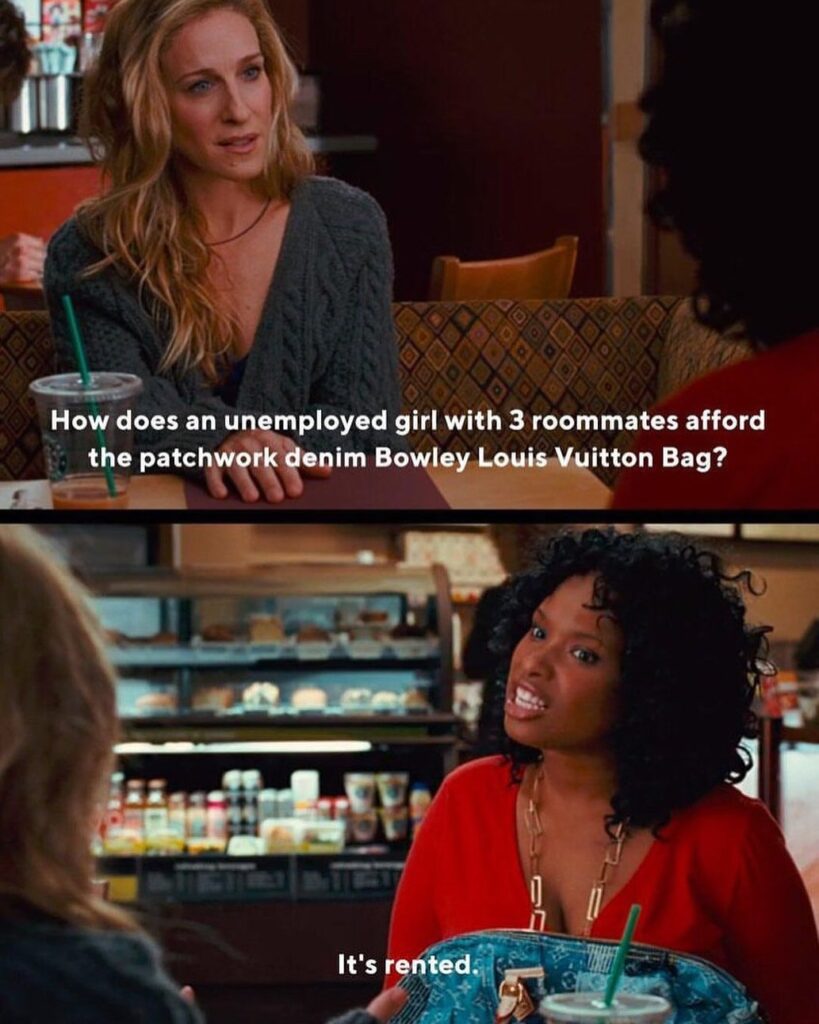

And did you know? Louis Vuitton even designed a custom trophy case for the FIFA World Cup. Because, obviously, only the most prestigious prize in sports deserves to travel in style.
Louis Vuitton isn’t just fashion; it’s pop culture, luxury, and history wrapped into one monogrammed masterpiece. No wonder it remains one of the most recognized and coveted logos in the world.


Fighting the Fakes 🛡️
Speaking of knockoffs… did you know the LV logo was one of the first “anti-fake” strategies in fashion?
Back in the late 1800s, Louis Vuitton trunks were all the rage, and everyone wanted one. Georges Vuitton had to protect the brand from imitators, and voilà, the LV monogram was born. And here we are, over a century later, and the Louis Vuitton logo is still one of the most copied symbols in the world.
In 2010 alone, the company undertook 10,673 legal actions and launched 30,171 anti-counterfeiting procedures globally. These efforts resulted in the seizure of thousands of counterfeit products and the shutdown of 1,250 illegal websites. (Louis Vuitton) It’s estimated that nearly 20% of all counterfeit accessories sold in the European Union bear the Louis Vuitton name.
To combat this ongoing issue, Louis Vuitton has a dedicated team for protecting its intellectual property rights
Fun fact: Louis Vuitton spends half its communications budget fighting counterfeits. That’s how iconic the monogram is—it’s not just a logo, it’s a legacy. And while fakes are everywhere, LV’s intricate designs and top-notch craftsmanship make the real thing unmistakable.
Isn’t it incredible how much effort goes into protecting such an iconic brand? But let’s be honest, nothing beats the real thing! 💁♀️
Why the Louis Vuitton Logo Is Still the Ultimate Travel Companion ✈️
From the moment Louis Vuitton started crafting travel trunks in the 1850s, the brand has been synonymous with luxury on the move. But more than just style, Louis Vuitton revolutionized travel itself. Before LV, trunks had domed lids, making them impossible to stack. Vuitton introduced the flat-top trunk, which not only made packing easier but also changed the way people traveled forever.
And let’s talk security—because what’s the point of a luxury trunk if your treasures aren’t safe? Enter Georges Vuitton, who in 1890 revolutionized luggage locks with an ingenious closing system that turned travel trunks into real-life treasure chests. The Tumbler Lock was so secure that Georges even challenged Harry Houdini to escape from one of his locked trunks (spoiler: Houdini never accepted).
From historic steamship voyages to private jet runways, the LV monogram has been stamped on some of the most iconic luggage pieces in history. Whether you’re packing light or bringing an entire wardrobe, Louis Vuitton is still the ultimate travel companion—because some logos are more than just decoration; they’re a passport to timeless luxury.

A Timeless Icon in a Changing World 💫
The Louis Vuitton logo isn’t just a fashion statement—it’s a story. A story of craftsmanship, innovation, and staying power in a fast-changing world. It connects us to a rich past while continuing to evolve and stay relevant. And honestly, who doesn’t want to carry that kind of energy with them?
So next time you spot that LV monogram—whether it’s on a bag, a trunk, or even a scarf—take a moment to appreciate the artistry, the legacy, and the sheer brilliance behind it. Because some things never go out of style, and the Louis Vuitton logo? It’s forever.

